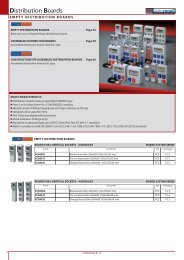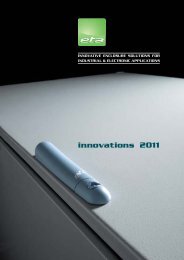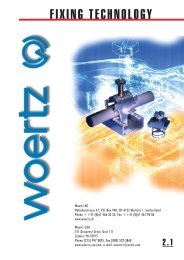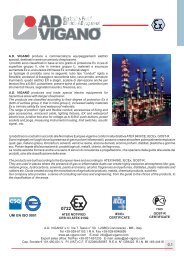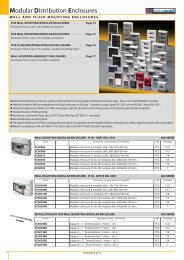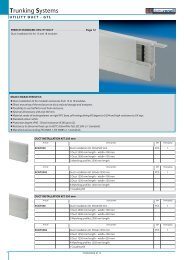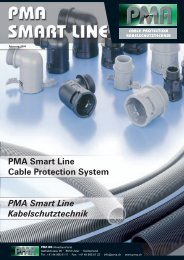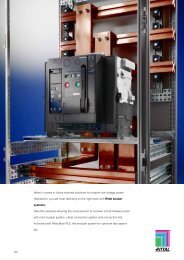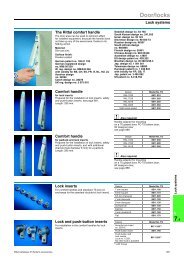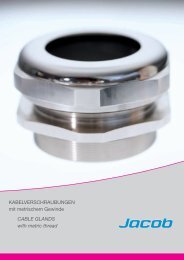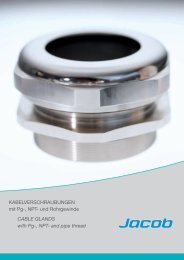Acme Product Catalog - Ranger Enterprise Company Limited
Acme Product Catalog - Ranger Enterprise Company Limited
Acme Product Catalog - Ranger Enterprise Company Limited
Create successful ePaper yourself
Turn your PDF publications into a flip-book with our unique Google optimized e-Paper software.
8<br />
1<br />
SECTION DRY-TYPE DISTRIBUTION TRANSFORMERS<br />
SECTION DRY-TYPE DISTRIBUTION TRANSFORMERS<br />
Example: Determine the interrupting capacity, in amperes, of<br />
a circuit breaker or fuse required for a 75 kVA, three phase<br />
transformer, with a primary of 480 volts delta and secondary<br />
of 208Y/120 volts. The transformer impedance (Z) = 5%. If the<br />
secondary is short circuited (faulted), the following capacities<br />
are required:<br />
Normal Full Load Current =<br />
Volt Amps 75,000 VA<br />
√ 3 x Line Volts √ 3 x 480 V<br />
90 Amps<br />
Maximum Short Circuit Line Current =<br />
Full Load Amps = 90 Amps<br />
5% 5%<br />
1,800 Amps<br />
The breaker or fuse would have a minimum interrupting rating of<br />
1,800 amps at 480 volts.<br />
NOTE: The secondary voltage is not used in the calculation.<br />
The reason is the primary circuit of the transformer is the only<br />
winding being interrupted.<br />
21. Can Single Phase Transformers be used for Three Phase<br />
applications? Yes. Three phase transformers are sometimes<br />
not readily available whereas single phase transformers can<br />
generally be found in stock. Three single phase transformers can<br />
be used in delta connected primary and wye or delta connected<br />
secondary. They should never be connected wye primary to wye<br />
secondary, since this will result in unstable secondary voltage.<br />
The equivalent three phase capacity when properly connected<br />
of three single phase transformers is three times the nameplate<br />
rating of each single phase transformer. For example: Three<br />
10 kVA single phase transformers will accommodate a 30 kVA<br />
three phase load.<br />
22. Does ACME provide “Zig-Zag” Grounding Transformers?<br />
Yes. Please refer to Page 31 for a special diagram which<br />
can be used to connect standard single phase off-the-shelf<br />
transformers in a three phase zig-zag manner. This system can<br />
be used for either grounding or developing a fourth wire from<br />
a three phase neutral. An example would be to change a 480<br />
V — three phase — three wire system to a 480Y/277 V — three<br />
phase — four wire system.<br />
23. What color are ACME Dry-Type Transformers?<br />
ASA 61 (NEMA) light gray is used on all enclosed transformers<br />
from .050 to 1000 kVA.<br />
24. How do you select a transformer to operate in an ambient<br />
higher than 40° centigrade?<br />
When the ambient exceeds 40°C use the following chart for<br />
de-rating standard transformers.<br />
Maximum Ambient Maximum Percentage<br />
Temperature of Loading<br />
40°C (104°F) 100%<br />
50°C (122°F) 92%<br />
60°C (140°F) 84%<br />
Instead of ordering custom built transformers to operate in<br />
ambients higher than 40°C, it is more economical to use a<br />
standard transformer of a larger kVA rating.<br />
ACME ELECTRIC MILWAUKEE, WI 800.334.5214 acmepowerdist.com<br />
25. Can transformers listed in this catalog be reconnected<br />
as autotransformers to increase their kVA rating? Several<br />
standard single phase transformers listed in this catalog can<br />
be connected as autotransformers. The kVA capacity will<br />
be greatly increased when used as an autotransformer,<br />
in comparison to the nameplate kVA as an insulating<br />
transformer. Examples of autotransformer applications are<br />
changing 600 volts to 480 volts in either single phase or three<br />
phase; changing 480 volts to 240 volts single or three phase<br />
or vice versa; or the developing of a fourth wire (neutral) from<br />
a 480 volt three phase three wire system for obtaining 277<br />
volts single phase. This voltage is normally used for operating<br />
fluorescent lamps or similar devices requiring 277 volts. For<br />
further details showing kVA and voltage combinations for<br />
various autotransformer connections refer to Page 30 and 31<br />
in this catalog.<br />
26. Are ACME Transformers shown in this catalog U.L.<br />
Listed? All of the transformers, with few exceptions, are<br />
listed by Underwriters’ Laboratories and have met their<br />
rigorous requirements. We are also prepared to have<br />
transformers, which are not presently listed, submitted for<br />
listing to Underwriters’ upon the customer’s request. Please<br />
contact the factory for details.<br />
27. Is CSA certification available for transformers shown in<br />
this catalog? Most ACME transformers shown in this catalog<br />
are certified by Canadian Standards Association. They have<br />
been designed and tested in accordance with the latest<br />
specifications. Please contact the factory if further details<br />
are required.<br />
28. What is BIL and how does it apply to transformers listed<br />
in this catalog?<br />
BIL is an abbreviation for Basic Impulse Level. Impulse tests<br />
are dielectric tests that consist of the application of a high<br />
frequency steep wave front voltage between windings, and<br />
between windings and ground. The Basic Impulse Level of<br />
a transformer is a method of expressing the voltage surge<br />
(lightning, switching surges, etc.) that a transformer will<br />
tolerate without breakdown. All transformers manufactured<br />
in this catalog, 600 volts and below, will withstand the NEMA<br />
standard BIL rating, which is 10 KV. This assures the user<br />
that he will not experience breakdowns when his system is<br />
properly protected with lightning arrestors or similar surge<br />
protection devices.<br />
29. What is polarity, when associated with a transformer?<br />
Polarity is the instantaneous voltage obtained from the primary<br />
winding in relation to the secondary winding. Transformers 600<br />
volts and below are normally connected in additive polarity —<br />
that is, when tested the terminals of the high voltage and low<br />
voltage windings on the left hand side are connect ed together,<br />
refer to diagram below. This leaves one high voltage and<br />
ADDITIVE<br />
POLARITY<br />
H1 H2<br />
240 VOLT<br />
INPUT<br />
120 VOLT<br />
OUTPUT<br />
x2 x1<br />
VOLT<br />
METER<br />
360<br />
VOLT<br />
READING



